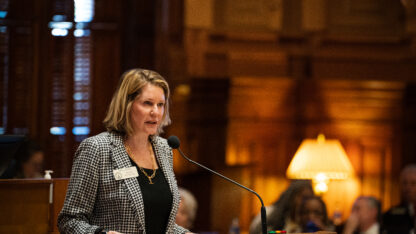A new report on U.S. pre-K programs ranked Georgia 9th in the nation for the percentage of 4-year-olds enrolled at 56%, but 25th for state spending per child at $5,646.
Researchers with the National Institute for Early Education Research found that Georgia meets eight out of 10 quality benchmarks and predicted a nearly $100 million increase in pre-K spending awaiting Gov. Brian Kemp’s signature will give Georgia youngsters a good head start.
According to NIEER’s 2023 State of Preschool Yearbook, released Thursday, class sizes and child-to-staff ratios kept the state from a perfect score. The authors dinged Georgia for its maximum class size of 22, above the benchmark of 20, and the staff-to child ratio of one to 11, when the recommendation is one to 10. Five states met all 10 benchmarks, which also include requirements like teacher training and professional development and vision and hearing screenings for students. The five states are Alabama, Hawaii, Michigan, Mississippi and Rhode Island.
Georgia lawmakers increased the allowed class size from 20 to 22 children for the 2012 school year in the aftermath of the Great Recession. The 2025 budget lawmakers approved last month is intended to fix that with an increase of $97 million for the lottery-funded program. Kemp has until May 7 to review and sign legislation, including the budget.
House Speaker Pro Tem Jan Jones, a Milton Republican, chaired a working group on early childhood education last year and led the push for more funding. The $97 million could help reduce the class size back down to 20 and meet other pre-k priorities including raising salaries for teachers, increasing startup grants and supporting transportation costs.
According to the working group, bringing the class size back down will mean increasing the number of pre-K classrooms in the state from 3,818 to 4,200 with an estimated cost of $43 million over four years.
“We applaud Georgia leaders for supporting a comprehensive package of research-based reforms to improve Georgia’s landmark pre-k program for the next generation. By restoring class sizes to the level recommended for strong student outcomes, Georgia’s pre-k program will become the largest program in the country that meets all 10 quality benchmarks recommended by NIEER,” said NIEER Senior Co-Director W. Steven Barnett.
“A key ingredient for pre-k effectiveness is a strong teacher interacting with children one-on-one and in small groups,” he added. “More of that will happen when class size is limited to 20, and the research is quite clear this leads to long-term student outcomes.”
The report gave Georgia’s program good marks for effectiveness, citing a longitudinal study released last spring that tracked children from pre-K to fourth grade.
“Children who had attended Georgia pre-K had better language, literacy, and executive function in fourth grade compared to children who did not attend any pre-K,” the NIEER report says. “Overall, results suggest that a key strength of Georgia’s Pre-K Program is building foundational literacy skills for reading.”
Georgia’s pre-K program launched in 1992 as a limited pilot program with the creation of the Georgia Lottery. Three years later, it expanded to become the nation’s first universal pre-K program for 4-year-olds.
In the 2022-2023 school year, 73,462 children enrolled in pre-K at a cost of $388.3 million of state money and an additional $26.4 million in federal recovery dollars.
This story was provided by WABE content partner Georgia Recorder.








